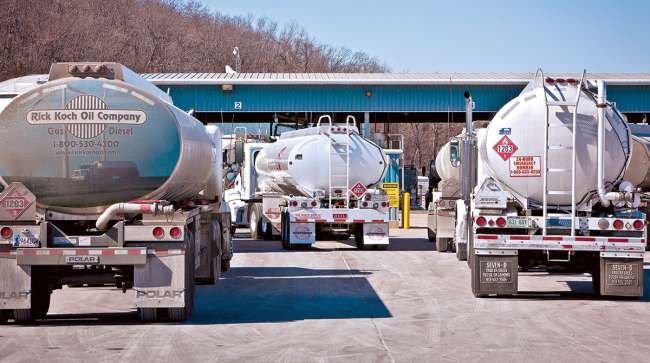Senior Reporter
Diesel Falls 5.4¢ to $2.956 Per Gallon

[Stay on top of transportation news: Get TTNews in your inbox.]
The U.S. average retail price of diesel tumbled 5.4 cents to $2.956 a gallon, the Department of Energy reported Feb. 3.
The same day, oil futures slid below $50 a barrel on growing fears the effect of the coronavirus that emerged in China — where millions were quarantined — could reduce output in that country, slow global supply chains and cut demand for oil and petroleum products.
The last time the diesel average was below $3 was Sept. 16 when it reached $2.987 per gallon.
Trucking’s main fuel costs 1 cent less than it did a year ago, when it was $2.966 a gallon, according to DOE.
All regional diesel prices fell, and dropped the most, 6.3 cents, in the Gulf Coast area.
The U.S. average price of a gallon of gasoline slid 5.1 cents to $2.455 per gallon, according to DOE’s Energy Information Administration. It was still 20.1 cents higher than a year earlier.
Average gasoline prices fell in all regions, including 7.2 cents, in the Lower Atlantic area, where it was $2.272.
Meanwhile, one president of a local and regional truckload carrier said routing software and idle reduction were important tools to improve fuel efficiency.

“We only have one terminal where we have onsite fuel. The rest of our tractors are based at dedicated accounts across the Midwest. It could be two at one location and 25 at another,” Nino Alagna, president of All Truck Transportation Co. Inc., told Transport Topics.
The Chicago-based carrier operates about 300 tractors and 1,700 trailers. It buys 3 million gallons of diesel fuel a year. The average amount of annual miles each truck covers is 125,000 miles.
“Our systems are fully integrated. So we have really had very good success recently with routing software, and really monitoring out-of-route miles to try to keep our mileage numbers down to conserve fuel,” Alagna said.
It’s a simple approach, he added. The software also steers drivers to suppliers who provide the fleet the best discounts.
Some older drivers don’t like the routing plan as much, he said, and they remember getting the bill of lading from the customer and going on a map and figuring out how to get there on their own.
But then the younger crew of drivers knows how it works — “everybody is addicted to GPS now. So, it is very acceptable to them. Almost to a point where they really want it. It’s a recruiting tool,” he said.
Alagna said he believes the routing software also creates a safer driver because drivers are staying on a real truck route. “They don’t get lost or put themselves in bad situations.”
Each of the carrier’s trucks also is equipped with an idle shutdown device.
In part one of a two-part exploration of autonomous technology today, our latest RoadSigns podcast revisits conversations with CEOs Alex Rodrigues of Embark and Cetin Mericli of Locomation. Hear them explain what testing automated trucks and developing platooning technology has taught them about the road ahead — and get new perspective with host commentary. Listen to a snippet from Rodrigues above, and to hear the full episode, go to RoadSigns.TTNews.com.
“Idling is a huge thing because we have some drivers who are dropping freight at docks six or seven times a day because we have such a shorthaul mentality. And so the amount of time they spend at those docks idling means something to us. Our idle time is way higher than the majority of fleets out there based on the businesses that we serve and how we do it,” Alagna said.
The North American Council for Freight Efficiency reported extended idle shutdown automatically restricts the amount of time an engine can idle. The fuel economy improvements can be in the 7% range depending on the actual amount of idle time that is reduced. When the engine is running but the vehicle is not moving and there is no operator interaction with the clutch, brake or accelerator, a timer begins a countdown. When the time expires, the engine control module shuts down the engine. An optional ambient air temperature sensor can be used to prevent engine shutdown in cold weather.
West Texas Intermediate crude futures on the New York Mercantile Exchange closed at $49.99 on Feb. 3 compared with $53.14 per barrel on Jan. 27.
The loss of demand as the world’s second-largest economy quarantines cities to limit the outbreak is starting to ripple around the globe, as some Chinese refineries slow down or halt operations, Bloomberg News reported. Concerns that a global glut will form may force OPEC and its allies to hold an emergency meeting to discuss cutting crude production further in an effort to stabilize prices.
“The fears are justified when you consider just how massively important China is to oil demand,” Robbie Fraser, senior commodities analyst at Summit Energy Services, told Bloomberg News. “The sentiment has been bearish for a while and you have the data backing it up.”
The World Health Organization has pushed back against suggestions of imminent breakthroughs on vaccines or treatments as efforts to stop the virus spreading ramp up.
Want more news? Listen to today's daily briefing:





